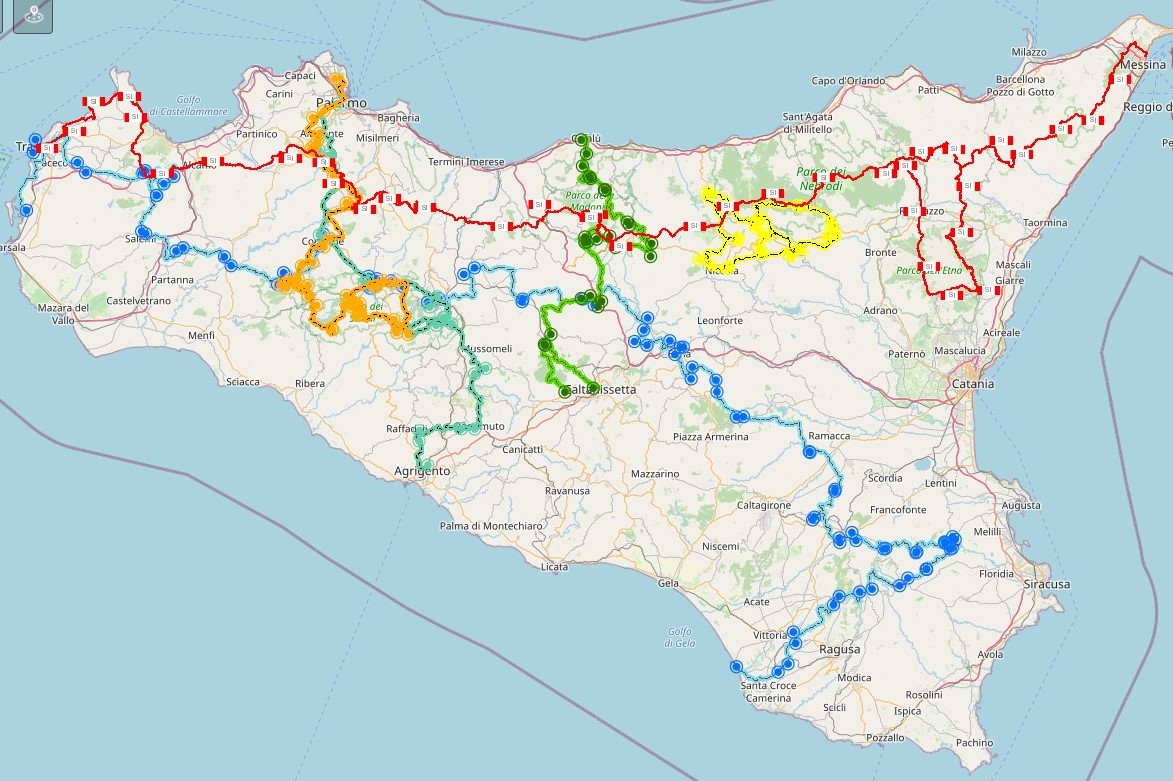Via Francigena Fabaria
Detail
The Via Fabaria is an important artery of the Sicilian Magna Via Francigena. Discovered as a result of landscape archaeology research, it revealed a series of Greek-Roman and medieval road sections with textual sources, maps and ancient cartography.
The Via Fabaria runs for about 300 kilometres, from the coasts of Agrigento to the volcanic lavas of Randazzo, the northern gateway to Mount Etna, passing through an extraordinary variety of historical and natural scenery where one can stop according to one’s interests.
In its total of 14 stages, the Via Fabaria skirts the sea that was once Magna Graecia until it reaches the most famous historical centres of Sicilian Baroque, with Simeto, Sicily’s main river, acting as a watershed.
The starting city for the itinerary along the Via Fabaria is Agrigento, world-famous for the Valley of the Temples, one of the most important testimonies of classical culture in the Mediterranean. A UNESCO World Heritage Site, the Valley of the Temples is a journey into ancient Akragas, one of the most important cities of Magna Graecia.
Second stop on the Via Fabaria is Palma di Montechiaro (AG), among the pearls of Sicilian Baroque. A “foundation city” ex novo, Palma was founded in the 16th century by the Tomasi di Lampedusa family, the same family of Giuseppe, author of ‘Il Gattopardo’. Not to be missed in the marina, the Montechiaro Castle.
In the province of Agrigento, Licata is a seaside town rich in history, natural beauty (Cala Paradiso, etc.) and the set of Il Commissario Montalbano (the famous TV series based on the literary character of the same name by Andrea Camilleri), as well as the birthplace of the singer Rosa Balistreri.
The fourth stage of the Via Fabaria passes through Falconara Castle, a landmark of the Middle Ages near Falconara, a seaside hamlet of Butera, in the province of Caltanissetta. Although remodelled, it is a fine example of a fortress by the sea.
We reach Gela (CL) and its important Archaeological Park, where we can admire evidence of the first Rhodium-Cretan colony on the island. A characteristic aspect of the historic centre? The renowned Gelese Liberty, the floral style of its stately buildings.
The town of Niscemi (CL) welcomes Via Fabaria walkers with a panoramic terrace on the Gela Plain (Belvedere Terrace) and dozens of churches and palaces ranging from the Norman to the Baroque period.
Caltagirone, the seventh stop on the Via Fabaria itinerary in the province of Catania, is famous for its handicraft tradition of artistic ceramics, amply represented in the Regional Museum of Ceramics.
The two stops in Grammichele and Militello (CT) tell the dramatic story of the 1693 earthquake. The first, ancient Occhiolà, was rebuilt ex novo by the Prince of Butera, Carlo Maria Carafa; the second, rebuilt in Sicilian Baroque style, is one of the 8 “Baroque Cities of the Val di Noto”, a UNESCO circuit.
Lentini (SR) and Paternò (CT), respectively the tenth and eleventh stops along the Via Fabaria, take us into the province of Syracuse, to discover a cross-section of contemporary Sicily, with a visit to the Lentini Urban Art Park and then on into more ancient history, from the Middle Ages to the events of the Unification of Italy.
We reach the town of Adrano (CT), where the archaeological evidence of the Via Fabaria ranges from the Neolithic to the Middle Ages and leaves traces at the Norman Castle, the numerous churches, the Cyclopean walls, aqueducts, mills and the Saracen Bridge.
We continue to Bronte (CT), world-famous for the production of the renowned Bronte Green Pistachio and a series of important religious and historical buildings, such as the Abbey of Santa Maria Maniace (or Maniace Castle).
The stage of arrival of the Via Fabaria is Randazzo (CT), one of the most representative medieval centres in the region. It can still be accessed through the ancient gates, a crossroads of Greek, Roman, Byzantine, Jewish, Arab, Norman and Aragonese peoples, each of whom left important traces of their passage.
For more information, visit the Via Fabaria website.
Regional web map of paths and routes for soft mobility realised by LabGis Tourist Observatory of the Region of Sicily, in collaboration with FIAB Sicilia and CAI Sicilia.
Share this content!
LOCATION
DURATION
Distance
300 KM
Difficulty
High
Places
Categories
AROUND









